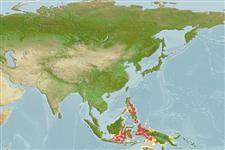Environment: milieu / climate zone / depth range / distribution range
Οικολογία
Θαλασσινό(ά) Υφαλόφιλο(α); μη μεταναστευτικό(ά); εύρος βάθους 5 - 33 m (Ref. 5222). Tropical; 20°N - 12°S, 111°E - 149°E (Ref. 5222)
Western Pacific: Philippines, Indonesia (Sulawesi, Flores), and Papua New Guinea.
Μέγεθος / Βάρος / Age
Maturity: Lm ? range ? - ? cm
Max length : 25.0 cm TL αρσενικό/απροσδιόριστο; (Ref. ); common length : 20.0 cm TL αρσενικό/απροσδιόριστο; (Ref. )
Ραχιαίες άκανθες (συνολικά): 9; Μαλακές ραχιαίες ακτίνες (συνολικά): 14; Εδρικές άκανθες 3; Μαλακές εδρικές ακτίνες: 8. Similar to the more common Cephalopholis spiloparaea but lacks banding in the caudal fin (Ref. 48635); characterized further by reddish brown color; base of pelvic fins with indistinct dark blotch; greatest body depth 2.5-2.9 in SL; rounded caudal fin; short pelvic fins, 2.3-2.5 in head length; strongly bilobed margin of front of upper lip (Ref. 90102); head length 2.1-2.3 times in SL; rounded preopercle, posterior edge finely serrate, lower edge fleshy; very convex upper edge of operculum; maxilla extends past eye; teeth large; midlateral-body scales ctenoid (Ref. 89707).
Inhabits protected or silty reef areas (Ref. 89707). Reported to be very habitat speciific, lives in very rich invertebrate habitat in the shore side of inner reefs and difficult to get shots u/w. Largest seen was about 25 cm, but usually smaller up to about 20 cm (R. Kuiter, pers. Comm. 03/2022). Maximum length given 40 cm TL (for confirmation) May undergo protogyny. Solitary (Ref 90102).
Life cycle and mating behavior
Γεννητική Ωρίμανση | Αναπαραγωγή | Γεννοβολία | Αβγά | Γονιμότητα | Προνύμφες
Heemstra, P.C. and J.E. Randall, 1993. FAO Species Catalogue. Vol. 16. Groupers of the world (family Serranidae, subfamily Epinephelinae). An annotated and illustrated catalogue of the grouper, rockcod, hind, coral grouper and lyretail species known to date. Rome: FAO. FAO Fish. Synop. 125(16):382 p. (Ref. 5222)
IUCN Red List Status (Ref. 130435)
Threat to humans
Harmless
Human uses
αλιεία: χωρίς ενδιαφέρον
Περισσότερες πληροφορίες
Κοινά ονόματαΣυνώνυμαΜεταβολισμόςΘηρευτέςΟικοτοξικολογίαΑναπαραγωγήΓεννητική ΩρίμανσηΓεννοβολίαΣυναθροίσεις γεννοβολίαςΓονιμότηταΑβγάEgg development
ΑναφορέςΥδατοκαλλιέργειεςΠροφίλ υδατοκαλλιέργειαςΣτελέχοιΓενετικήElectrophoresesΚληρονομικότηταΑσθένειεςΜεταποίησηNutrientsMass conversion
ΣυνεργάτεςΦωτογραφίεςStamps, Coins Misc.ΉχοιΣιγκουατέραΤαχύτηταΚολυμβητικός ΤύποςΕπιφάνεια βραγχίωνOtolithsΕγκέφαλοιΌραση
Εργαλεία
Special reports
Download XML
Διαδικτυακές πηγές
Estimates based on models
Preferred temperature (Ref.
123201): 28 - 29.1, mean 28.5 °C (based on 68 cells).
Phylogenetic diversity index (Ref.
82804): PD
50 = 0.5000 [Uniqueness, from 0.5 = low to 2.0 = high].
Bayesian length-weight: a=0.01259 (0.00590 - 0.02687), b=3.04 (2.87 - 3.21), in cm total length, based on LWR estimates for this Genus-body shape (Ref.
93245).
Τροφικό Επίπεδο (Ref.
69278): 4.0 ±0.7 se; based on size and trophs of closest relatives
Ελαστικότητα (Ref.
120179): Υψηλό, ελάχιστος χρόνος για διπλασιασμό πληθυσμού < 15 μήνες (Preliminary K or Fecundity.).
Fishing Vulnerability (Ref.
59153): Low vulnerability (15 of 100).
Nutrients (Ref.
124155): Calcium = 47.3 [25.4, 82.5] mg/100g; Iron = 0.488 [0.263, 0.915] mg/100g; Protein = 18.7 [16.9, 20.4] %; Omega3 = 0.16 [0.10, 0.26] g/100g; Selenium = 33.2 [15.9, 57.7] μg/100g; VitaminA = 108 [37, 349] μg/100g; Zinc = 0.835 [0.594, 1.369] mg/100g (wet weight);
